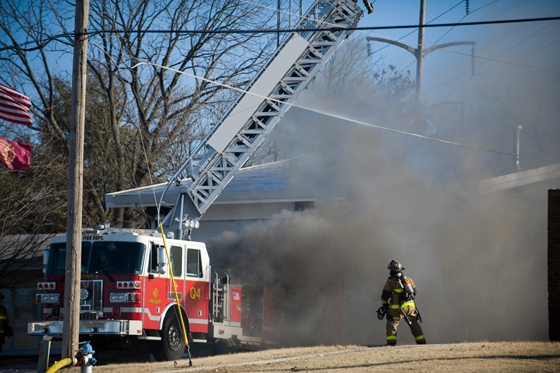| Aerial equipment safety |
Aerial apparatus are some of the most effective tools used by the fire service – and some of the most dangerous. Every year, incidents involving aerial apparatus place firefighters’ lives in jeopardy and destroy expensive equipment. The majority of these accidents occur during non-emergency operations, such as inspection, training and maintenance. You and your crew must be constantly vigilant to avoid contacting or coming close to power lines and energizing aerial equipment.
|
 |
| Contacting power lines with aerial equipment can be a million-dollar mistake. Often these events place firefighters’ lives in jeopardy and destroy expensive equipment. There is an easy solution: Use a spotter! |
Distance and situational awareness are your best friends
Before raising any ladders or extending aerial equipment, confirm that “the overhead is clear” and identify the location of all overhead power lines in the vicinity, including the service drops that run from utility poles to buildings. Contact with any energized line can injure your crew and destroy your equipment. |
| Follow these precautions to ensure your aerial equipment stays a safe distance from all overhead lines: |
| Position apparatus so that fully extended aerial equipment remains at least 10 feet away from power lines up to 50 kV. Higher voltages require greater distance. Confirm line voltages and clearances with National Grid. Remember: 10 feet is the minimum distance. Always maintain the maximum distance possible. Consider wind and weather conditions that may cause power lines to move or increase the possibility of electricity arcing to the apparatus. |
Utilize a dedicated spotter/safety officer to monitor the deployment of ladders and aerial apparatus to ensure they remain a safe distance away from power lines and service wires. While it may be difficult to make this resource available during emergency operations, it is critical to protecting both personnel and equipment. Best practice demands having a spotter present during inspection, training and maintenance procedures. |
| Position a spotter on the ground at least 30 feet away from the aerial apparatus, and have them communicate to the operator by radio. A spotter cannot operate from the turntable, where they do not have the perspective necessary to judge the equipment’s distance from the power lines. The spotter should remember the danger of step potential and shuffle away with both feet on the ground at all times if the aerial apparatus becomes energized. |
| Consider potential line failure. During firefighting operations, utility lines may sag or fail. Falling lines may strike and energize your apparatus, metal gutters, metal roofs, metal fences or other conductive objects. Considering line failure should be part of your initial size-up and your decision-making during apparatus placement. |
| When possible, DO NOT stand on the ground when operating aerial equipment. When equipment hits a line, people standing on the ground are in the greatest danger. Stay on the equipment instead, so you will be safe from electric shock if your extended aerial contacts a power line. |
In case of power line contact
If your aerial apparatus contacts a power line and there is no immediate danger, take these steps: |
| • |
 |
Stay on the equipment and call National Grid. You are safe as long as you remain on the equipment. |
|
| • |
 |
Warn others to stay at least 30 feet away. |
|
| • |
 |
If you can do so safely, move the apparatus away from the power line. |
|
| • |
 |
If you cannot move the equipment, stay put until National Grid personnel inform you the line has been de-energized. |
|
| |
|
| If you must get off the equipment due to fire or other imminent danger, follow these steps: |
| • |
 |
Do NOT step off the equipment and do NOT touch the equipment and the ground at the same time. If you do, you will become electricity’s path to the ground and you will be seriously – or fatally – shocked. |
|
| • |
 |
Jump clear of the equipment and land with your feet together. |
|
| • |
|
Shuffle away with small steps, keeping your feet close together and on the ground at all times. |
| • |
|
Continue shuffling until you are at least 30 feet away from distribution lines and 100 feet away from transmission lines. |
| • |
 |
Do not run or take large steps. If the ground is energized and your legs bridge two areas of different voltage, you could be fatally shocked. |
|
|
|
|
Case study
During maintenance to apply lubricant, crew members extended their aerial ladder over the cab at a relatively low angle, between power lines in front of their station. The turntable was approximately 86 feet from the power lines. The operator had retracted the ladder about five feet when it contacted a 19,900-volt power line. As the aerial ladder struck the power line, a firefighter was completing his check of the EMS equipment and heard a loud boom as “something exploded in the compartment.” Firefighters who witnessed the event reported seeing an arc from the compartment strike the firefighter in the chest. The injured firefighter was transported to the hospital for evaluation. |
|
|
Keep yourself, your team and the public safe this winter.
Visit firstresponder.ngridsafety.com today to register and
complete your utility safety training.
Learn more electrical and gas utility response tips at firstresponder.ngridsafety.com. |